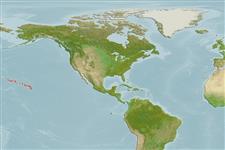>
Ovalentaria/misc (Various families in series Ovalentaria) >
Pomacentridae (Damselfishes) > Glyphisodontinae
Etymology: Abudefduf: Arabic, abu = father; this fish is the leader of the reef against other species (Ref. 45335).
More on authors: Quoy & Gaimard.
Environment: milieu / climate zone / depth range / distribution range
Écologie
marin récifal; non migrateur; profondeur 1 - 50 m (Ref. 9710). Tropical; 28°N - 15°S, 176°W - 154°W (Ref. 56014)
Eastern Central Pacific: Midway Islands (Ref. 7247) and Hawaii southward to central Polynesia.
Taille / Poids / Âge
Maturity: Lm ? range ? - ? cm
Max length : 30.0 cm TL mâle / non sexé; (Ref. 9710)
Description synthétique
Clés d'identification | Morphologie | Morphométrie
Épines dorsales (Total) : 13; Rayons mous dorsaux (Total) : 13 - 15; Épines anales: 2; Rayons mous anaux: 13 - 15. Similar to A. bengalensis but has fewer vertical stripes, a black blotch on the posterior base of the dorsal and anal fins, and pointed caudal fin lobes.
Found in quiet waters with rocky bottoms in inshore and offshore reefs; juveniles sometimes found in surge pools (Ref. 205). Benthopelagic (Ref. 58302). Adults form school. Feed on a variety of algae and zooplankton. Oviparous, distinct pairing during breeding (Ref. 205). Eggs are demersal and adhere to the substrate (Ref. 205). Males guard and aerate the eggs (Ref. 205). Used as food by the Hawaiians (Ref. 7364).
Life cycle and mating behavior
Maturities | Reproduction | Spawnings | Egg(s) | Fecundities | Larves
Distinct pairing (Ref. 205). Male guards and aerates eggs (Ref. 205).
Allen, G.R., 1991. Damselfishes of the world. Mergus Publishers, Melle, Germany. 271 p. (Ref. 7247)
Statut dans la liste rouge de l'IUCN (Ref. 130435)
Menace pour l'homme
Harmless
Utilisations par l'homme
Pêcheries: commercial; Aquarium: Commercial
Outils
Articles particuliers
Télécharger en XML
Sources Internet
Estimates based on models
Preferred temperature (Ref.
123201): 24.2 - 25.5, mean 25.1 °C (based on 54 cells).
Phylogenetic diversity index (Ref.
82804): PD
50 = 0.5000 [Uniqueness, from 0.5 = low to 2.0 = high].
Bayesian length-weight: a=0.02630 (0.01386 - 0.04993), b=3.11 (2.95 - 3.27), in cm total length, based on LWR estimates for this species & Genus-body shape (Ref.
93245).
Niveau trophique (Ref.
69278): 3.0 ±0.33 se; based on food items.
Résilience (Ref.
120179): Milieu, temps minimum de doublement de population : 1,4 à 4,4 années (Preliminary K or Fecundity.).
Fishing Vulnerability (Ref.
59153): Low vulnerability (20 of 100).
Nutrients (Ref.
124155): Calcium = 51.9 [27.3, 83.3] mg/100g; Iron = 0.561 [0.351, 0.878] mg/100g; Protein = 18.4 [17.3, 19.5] %; Omega3 = 0.104 [0.068, 0.158] g/100g; Selenium = 31.9 [18.8, 56.0] μg/100g; VitaminA = 63.3 [18.2, 207.4] μg/100g; Zinc = 1.24 [0.88, 1.74] mg/100g (wet weight);
